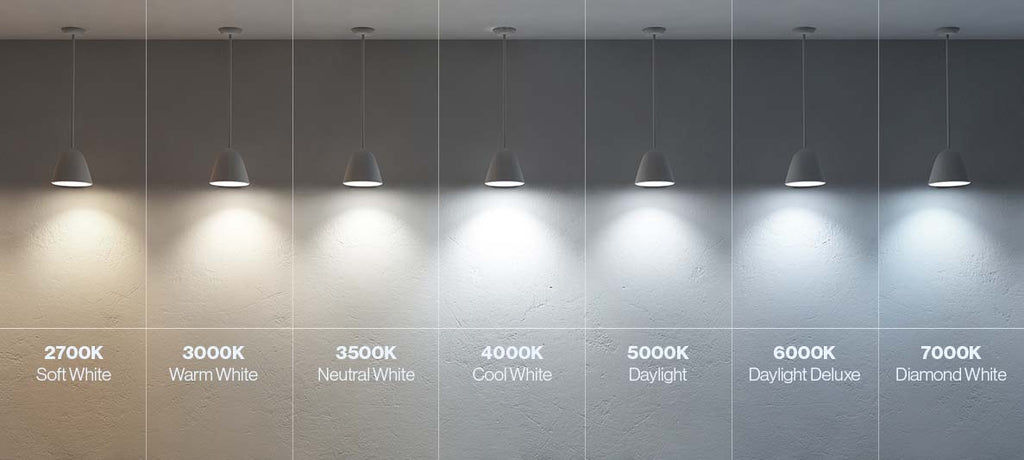What Is Color Temperature? A Homeowner’s Guide to Better Lighting
Have you ever walked into a room and instantly felt relaxed—or, on the flip side, suddenly more awake and alert? That reaction often has less to do with the décor and more to do with the lighting. Specifically, it’s about color temperature and a concept called CCT, or Correlated Color Temperature. Understanding these terms can help you choose the right LED light bulbs for every space in your home or workspace.

What Is Color Temperature?
Color temperature is measured in Kelvin (K), but don’t confuse that with how hot or bright a bulb gets. Instead, Kelvin is used to describe the appearance of the light. At the lower end of the Kelvin scale, light looks warm, with tones of amber and soft white. As the number climbs higher, light shifts to cooler tones, ranging from bright white to even a sharp, blue tone.
For example, a candlelit dinner gives off a glow of around 2000K, which feels intimate and soothing. Move up to 3000K, and you get a warm white light that’s still inviting but a bit brighter—ideal for living room lighting or bedrooms. On the cooler end of the spectrum, around 5000K to 6500K, you’ll find light that mimics natural daylight, which is perfect for kitchen lighting, offices, or garages where you need focus and precision.
![]()
![]()
![]()

![]() Warm vs. Cool: Finding the Right Feel
Warm vs. Cool: Finding the Right Feel
The way light makes us feel is often just as important as how it looks. Warm lighting is calming and comfortable, which makes it perfect for areas where you want to relax, such as bedrooms, dining rooms, or living rooms. Cooler light feels cleaner and sharper. It’s energizing and ideal for spaces where clarity matters, like offices, bathrooms, or studios.
When choosing your LED lighting, think about how you use the space. Do you want to unwind at the end of the day? Stick with warmer tones. Need to stay sharp while working on a project? Cooler tones will help keep you alert.
What Exactly Is CCT?
CCT, or Correlated Color Temperature, goes a step further. It doesn’t just describe the Kelvin rating of a bulb—it explains how the color of light appears to us. Imagine comparing the glow of a candle, the midday sun, and the light just before sunset. Each of these has a different color temperature, but they also feel different. CCT helps translate those differences into practical lighting choices for your home.

Don’t Forget About CRI
Another factor to consider is CRI, or Color Rendering Index. This measures how accurately colors appear under a light source compared to natural daylight. A high CRI rating means that colors look true and vibrant, which matters for spaces like kitchens, art studios, or anywhere you want accuracy.
Sunco LEDs generally offer CRI ratings of 80 to 95, so you can count on natural, reliable lighting whether you’re preparing food, showcasing artwork, or simply enjoying your space.
Matching Lighting to Your Lifestyle
So how do you put this into practice? Start by matching your lighting to your lifestyle. For cozy spaces where you want to relax, such as bedrooms and living rooms, lower Kelvin levels between 2000K and 3000K are a safe bet. For everyday spaces like kitchens or bathrooms, a range between 3000K and 4000K strikes a good balance. And for task-driven environments like workshops or offices, higher Kelvin lighting in the 4000K to 6000K range delivers the focus you need.
You can browse LED downlights, LED shop lights, and other fixtures to find the right fit for each space.

Smarter Ways to Light
The good news is you don’t have to pick just one color temperature and stick with it. With Smart Bulbs or Selectable CCT fixtures, you can adjust your lighting to suit the moment.
Maybe you prefer a crisp, bright workspace during the day, but want a softer, cozier feel at night. With adjustable options, you can shift between settings without replacing a single bulb. It’s an easy way to make your lighting as flexible as your lifestyle.
The Bottom Line
Lighting does more than brighten a room—it shapes the way we feel, focus, and connect in our spaces. By understanding the Kelvin scale, CCT, and CRI, you can choose lighting that works with your daily routines, whether you’re winding down, working hard, or entertaining guests. And with today’s smart LED lighting solutions, creating the perfect atmosphere is simpler than ever.



